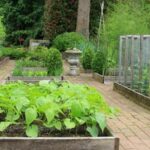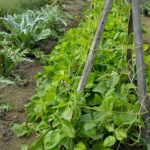Are you looking to bring the joy of gardening indoors? If so, books on indoor vegetable gardening can provide you with valuable information and practical tips to get started. Indoor vegetable gardening is a great way to enjoy fresh produce year-round, regardless of the outdoor climate or space limitations. In this article, we will explore the benefits of growing vegetables indoors and review the top 5 books on indoor vegetable gardening to help you kickstart your journey.
Indoor vegetable gardening offers numerous benefits, from having access to fresh, organic produce at your fingertips to creating a calming and rewarding hobby. Whether you live in an apartment with limited outdoor space or simply want to have a small garden inside your home, indoor vegetable gardening allows you to cultivate a wide variety of crops right in your living space. With the right knowledge and resources, even beginners can successfully grow their favorite veggies indoors.
To help you embark on your indoor vegetable gardening journey, we have compiled a list of the top 5 books on the topic that cover everything from choosing the right containers and soil mix to proper lighting and watering techniques. These books provide helpful insights and guidance for both novice and experienced indoor gardeners alike.
Whether you are interested in learning about organic methods or maximizing space efficiency for growing vegetables indoors, these books offer valuable information to support your endeavors.
Benefits of Growing Vegetables Indoors
Indoor vegetable gardening offers a range of benefits that make it an attractive option for both experienced and novice gardeners. One of the main advantages is the ability to grow fresh, organic produce year-round, regardless of the outdoor climate.
This means having access to a constant supply of home-grown vegetables, which can significantly reduce grocery expenses and contribute to a healthier lifestyle. Additionally, indoor gardening allows for greater control over environmental factors such as light, temperature, and humidity, leading to higher yields and better quality crops.
Another key benefit of growing vegetables indoors is the limited space required. Many urban dwellers or individuals living in apartments may not have access to large outdoor garden plots. Indoor gardening provides a practical solution for those with restricted space, as it can be done using small containers, vertical gardens, or hydroponic systems. This allows anyone with a sunny windowsill or countertop space to embark on their own indoor vegetable growing journey.
Lastly, indoor vegetable gardening can be a therapeutic and rewarding activity for individuals of all ages. Taking care of plants can reduce stress and anxiety, while also providing a sense of accomplishment as seeds transform into thriving plants bearing delicious fruits and vegetables. This hands-on experience can also be an educational opportunity for children to learn about nature and sustainability right at home.
| Benefits | Details |
|---|---|
| Fresh Produce Year-Round | Indoor gardening allows for year-round access to fresh organic produce. |
| Limited Space Required | Practical solution for individuals with restricted outdoor space. |
| Therapeutic Activity | Gardening can reduce stress and provide a sense of accomplishment. |
Top 5 Books on Indoor Vegetable Gardening
When it comes to indoor vegetable gardening, having the right resources is essential for success. Whether you’re a beginner or an experienced gardener, there are numerous books available that can provide valuable information and tips for growing vegetables indoors. Here are the top 5 books on indoor vegetable gardening that every aspiring indoor gardener should consider adding to their collection:
- “The Vegetable Gardener’s Container Bible” by Edward C. Smith – This comprehensive guide focuses on container gardening, making it perfect for those limited by space. The book covers everything from choosing the right containers to selecting the best vegetables for indoor cultivation.
- “Indoor Kitchen Gardening” by Elizabeth Millard – This book provides practical advice for growing a variety of vegetables indoors, and also includes delicious recipes for using your homegrown produce in the kitchen.
- “The Year-Round Vegetable Gardener” by Niki Jabbour – For those interested in year-round indoor gardening, this book offers techniques and strategies for extending the growing season and maximizing harvests indoors.
- “Grow Food at Home: Simple Methods for Small Spaces” by John Tullock – Tullock’s book is ideal for beginners looking to start their indoor vegetable garden. It covers basic gardening principles while emphasizing simplicity and ease of use.
- “The Complete Houseplant Survival Manual” by Barbara Pleasant – While not exclusively focused on vegetable gardening, this book provides valuable insights into caring for houseplants, which can be beneficial knowledge when cultivating vegetables indoors.
Each of these books offers unique perspectives and insights into the world of indoor vegetable gardening, making them essential reads for anyone hoping to grow their own produce within the confines of their home. Whether you’re interested in container gardening, year-round cultivation, or simply starting small with potted plants, there’s a book on this list that can provide the guidance and inspiration you need to succeed.
In addition to these top 5 books on indoor vegetable gardening, there are countless other resources available to help you become a successful indoor gardener. From online articles and forums to instructional videos and workshops, it’s important to explore all avenues in order to expand your knowledge and skills in this increasingly popular form of gardening.
By educating yourself with the right materials and continuously seeking new information, you can set yourself up for a bountiful harvest of fresh vegetables grown right inside your own home.
Book Review
There are numerous resources available for individuals who are interested in learning more about indoor vegetable gardening. One of the top books on this topic is “Indoor Gardening: The Organic Way.” This book provides a comprehensive guide to growing vegetables indoors using organic methods, making it an essential resource for anyone looking to cultivate their own indoor garden.
“Indoor Gardening: The Organic Way” offers practical tips and techniques for successfully growing a variety of vegetables within the confines of your home. From selecting the right containers and soil mixtures to implementing natural pest control methods, this book covers all aspects of indoor gardening in a sustainable and environmentally-friendly manner. Additionally, the book delves into the benefits of organic gardening, explaining how it can lead to healthier and more nutritious produce.
One of the standout features of “Indoor Gardening: The Organic Way” is its emphasis on simplicity and accessibility. The author provides clear and easy-to-follow instructions that are suitable for both novice and experienced gardeners alike.
Whether you have limited space or lack outdoor gardening options, this book equips readers with the knowledge needed to successfully grow their own vegetables indoors. Overall, “Indoor Gardening: The Organic Way” is a valuable resource for those looking to embrace sustainable living and harness the benefits of indoor vegetable gardening.
Book Review
The Complete Guide to Growing Vegetables Indoors is a comprehensive book that provides everything a beginner or experienced indoor gardener needs to know. Written by renowned horticulturist, Sarah Green, this book covers all aspects of indoor vegetable gardening, from choosing the right containers and soil to selecting the best vegetables for indoor growing. Green’s extensive knowledge and clear writing style make this book easy to understand for gardeners of all levels.
Comprehensive Coverage
One of the standout features of this book is its in-depth coverage of various techniques and methods for successful indoor vegetable gardening. Whether you are interested in hydroponics, aquaponics, or traditional container gardening, The Complete Guide to Growing Vegetables Indoors has you covered. Green also discusses the importance of light, water, and temperature control when growing vegetables indoors, providing valuable insights that can help readers avoid common pitfalls.
Practical Tips and Advice
Another highlight of this book is the practical advice and tips provided by the author. From troubleshooting common issues like pests and diseases to maximizing limited space for growing vegetables, Green offers actionable solutions based on her years of experience. Whether you have a small apartment or a spacious home, this book provides guidance on how to make the most out of your indoor gardening space.
Inspiring Success Stories
In addition to practical information, The Complete Guide to Growing Vegetables Indoors also includes inspiring success stories from indoor gardeners around the world. These anecdotes serve as motivation for readers who may be hesitant about starting their own indoor vegetable garden. Seeing real-life examples of successful indoor gardens can instill confidence and provide valuable insights into what works in different environments.
Overall, The Complete Guide to Growing Vegetables Indoors is an essential resource for anyone looking to dive into indoor vegetable gardening. With its comprehensive coverage, practical advice, and inspirational stories, this book equips readers with the knowledge and confidence they need to grow bountiful produce indoors.
Tips for Successful Indoor Vegetable Gardening
Indoor vegetable gardening can be a rewarding and enjoyable hobby, but it does require some special considerations. Here are some tips to help you succeed with your indoor vegetable garden.
Choose the Right Location
When setting up your indoor vegetable garden, it’s important to choose the right location. Most vegetables need at least six hours of sunlight each day, so select a spot in your home that receives ample natural light. If you don’t have a sunny window, you may need to invest in some grow lights to ensure that your plants get the light they need to thrive.
Select the Right Containers
The containers you choose for your indoor vegetable garden can have a big impact on your plants’ success. Make sure the containers have drainage holes to prevent water from accumulating and causing root rot. Additionally, consider the size of the container – some vegetables, like tomatoes and peppers, need larger pots to accommodate their root systems.
Pay Attention to Watering and Humidity
Indoor environments can be dry, especially in the winter when the heat is running. Keep a close eye on your plants and water them when the top inch of soil feels dry to the touch. You may also need to increase humidity levels around your plants by misting them or using a humidifier.
By following these tips and investing time in learning from experienced indoor gardeners through books on indoor vegetable gardening, you can set yourself up for success with growing vegetables inside your home.
Common Mistakes to Avoid in Indoor Vegetable Gardening
When starting an indoor vegetable garden, it’s easy to make mistakes that can hinder the growth and health of your plants. By being aware of these common pitfalls, you can avoid them and set yourself up for a successful indoor gardening experience.
One common mistake in indoor vegetable gardening is overwatering. It’s easy to believe that your plants need constant hydration, but in reality, overwatering can lead to root rot and other issues. It’s important to research the specific watering needs of each type of vegetable you’re growing and invest in a moisture meter to accurately gauge when it’s time to water.
Another mistake is neglecting proper lighting for your indoor vegetable garden. Natural light is often not sufficient for growing vegetables indoors, so investing in quality grow lights is essential. Without adequate lighting, your plants may become leggy, weak, and unable to produce healthy fruits or vegetables.
Additionally, using the wrong type or size of containers for your indoor garden can also be a common mistake. The size and material of your containers can impact the growth and health of your vegetable plants. It’s important to choose containers that allow for proper drainage and provide enough space for the roots to grow.
| Common Mistakes | Impact |
|---|---|
| Overwatering | Root rot and other issues |
| Neglecting proper lighting | Leggy, weak plants |
| Using wrong containers | Impacted growth and health of plants |
Conclusion
The future of indoor vegetable gardening looks promising as more and more people are taking an interest in growing their own food at home. With the advancement of technology, indoor gardening has become more accessible and easier to manage, making it a popular choice for urban dwellers and those with limited outdoor space. The future of indoor vegetable gardening is bright, with new innovations and techniques being developed to make the process even more efficient and productive.
One of the key factors contributing to the growth of indoor vegetable gardening is the increasing awareness of the benefits it offers. Not only does it provide a sustainable source of fresh produce, but it also promotes a healthier lifestyle and reduces carbon footprint by minimizing transportation of food from farm to table. Additionally, the satisfaction of growing your own vegetables and herbs indoors is unmatched, adding a sense of accomplishment and connection to nature.
For those interested in starting their own indoor vegetable garden, there are numerous resources available to guide them through the process. This includes a wide array of books on indoor vegetable gardening that provide valuable insights, tips, and techniques for successful cultivation. These books cover topics such as choosing the right containers, selecting the best plants for indoors, proper lighting and watering methods, pest control, and harvesting. Some popular books on indoor vegetable gardening include:
- “The Year-Round Vegetable Gardener” by Niki Jabbour
- “Indoor Edible Garden” by Zia Allaway
- “The Indoor Kitchen Garden” by Elizabeth Millard
As we look towards the future, it’s clear that indoor vegetable gardening will continue to gain momentum as more people seek sustainable and convenient ways to grow their own food. With the wealth of information available in books on indoor vegetable gardening, beginners can easily embark on this rewarding journey with confidence and success.
Bonus Section
In conclusion, the future of indoor vegetable gardening looks promising. With the increasing interest in sustainable living and food security, more and more people are turning to indoor gardening as a way to grow their own food year-round. The availability of a wide variety of books on indoor vegetable gardening also shows that there is a growing demand for knowledge and information in this area.
The top 5 books on indoor vegetable gardening provide valuable insights and practical tips for beginners and experienced gardeners alike. Whether it’s learning about the benefits of growing vegetables indoors or understanding the common mistakes to avoid, these books offer a wealth of information to help you succeed in your indoor gardening endeavors. Additionally, the book reviews for “Indoor Gardening: The Organic Way” and “The Complete Guide to Growing Vegetables Indoors” highlight the comprehensive nature of these resources.
As more people embrace sustainable living and seek ways to reduce their environmental impact, indoor vegetable gardening offers a convenient and accessible solution. With the right knowledge and resources, anyone can enjoy the satisfaction of growing their own fresh produce at home, regardless of space limitations or climate restrictions.
As we continue to explore innovative methods for food production, indoor vegetable gardening is likely to play an increasingly important role in our sustainable future. So pick up one of these books on indoor vegetable gardening today and start reaping the rewards of growing your own food indoors.
Frequently Asked Questions
How Do You Start an Indoor Vegetable Garden for Beginners?
Starting an indoor vegetable garden for beginners can be relatively easy. Begin by choosing a suitable location with ample light, selecting the right containers and soil, and deciding which vegetables to grow. It’s essential to research each vegetable’s specific needs to ensure successful growth.
What Veggies Grow Best Indoors?
Several veggies grow well indoors, including leafy greens like lettuce, spinach, and kale. Herbs such as basil, cilantro, and parsley also thrive indoors. Other options include cherry tomatoes, peppers, and radishes. It’s important to consider factors like lighting and space when choosing which vegetables to grow indoors.
Is an Indoor Vegetable Garden Worth It?
An indoor vegetable garden can certainly be worth it for many people. It provides a convenient and accessible source of fresh produce, especially for those with limited outdoor space. Additionally, growing your own veggies indoors allows you to have more control over the growing conditions and eliminates exposure to pesticides often found on store-bought produce.

If you’re looking to get into vegetable gardening, or are just looking for some tips on how to make your current garden better, then you’ve come to the right place! My name is Ethel and I have been gardening for years. In this blog, I’m going to share with you some of my best tips on how to create a successful vegetable garden.





